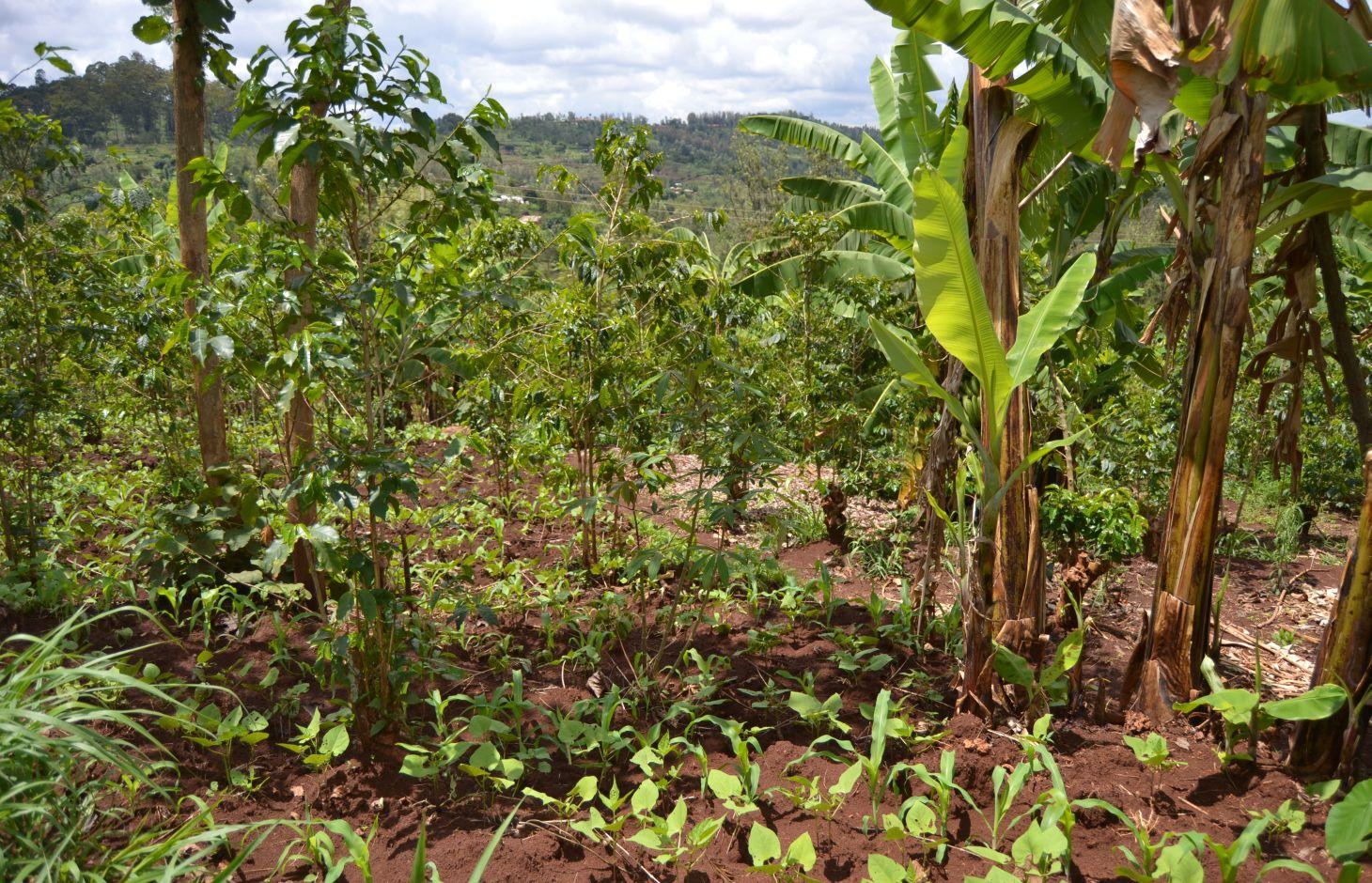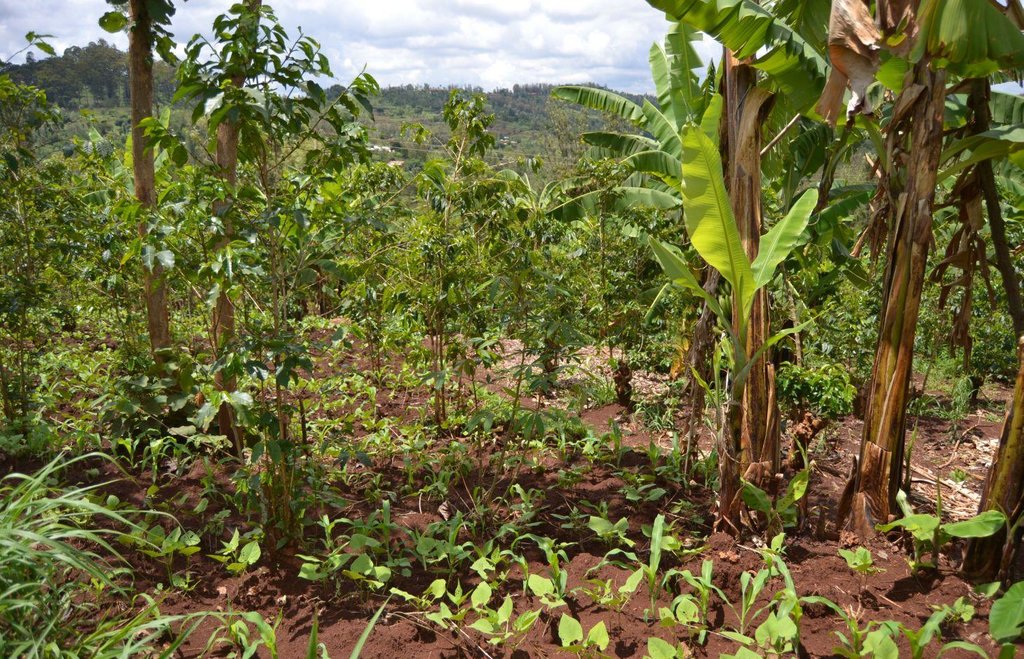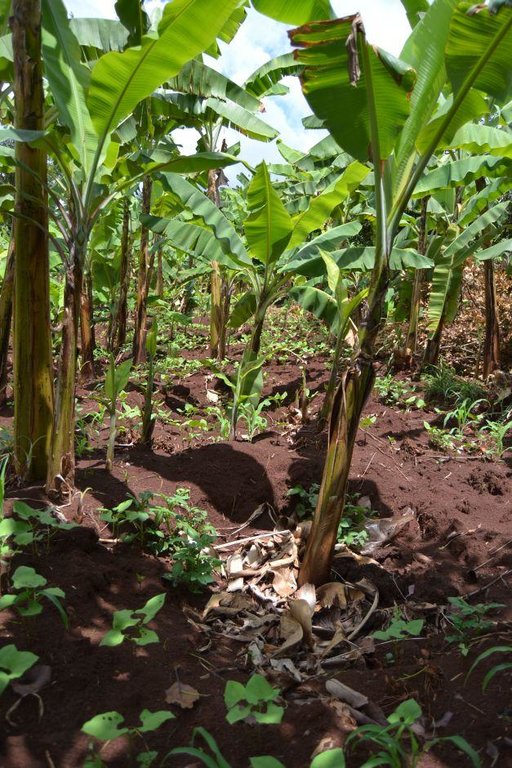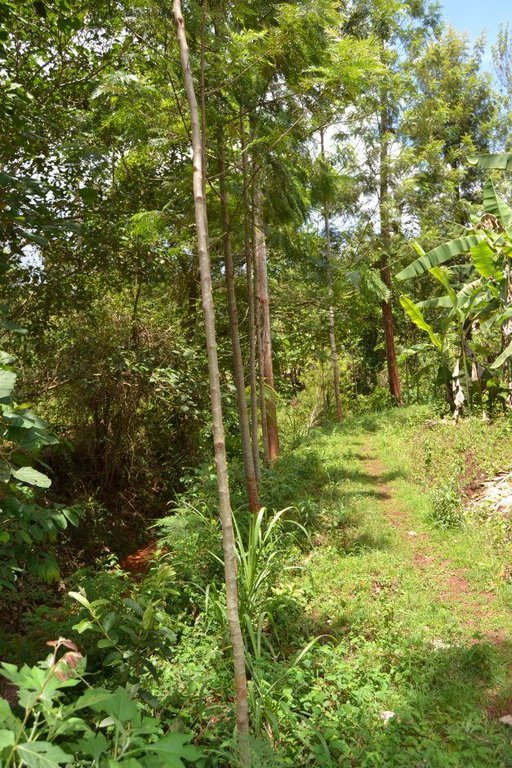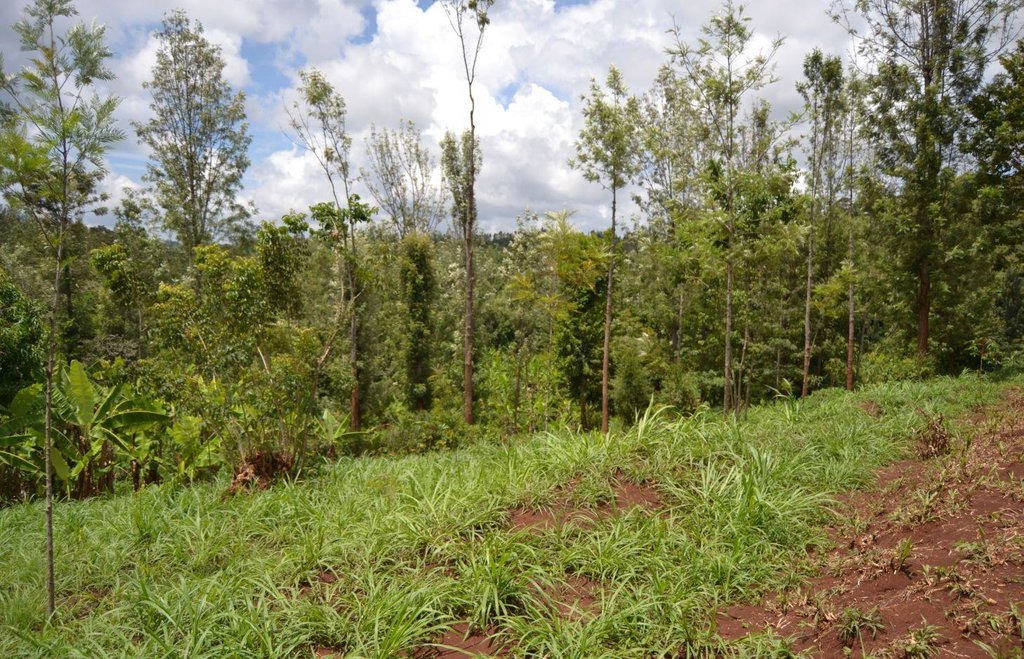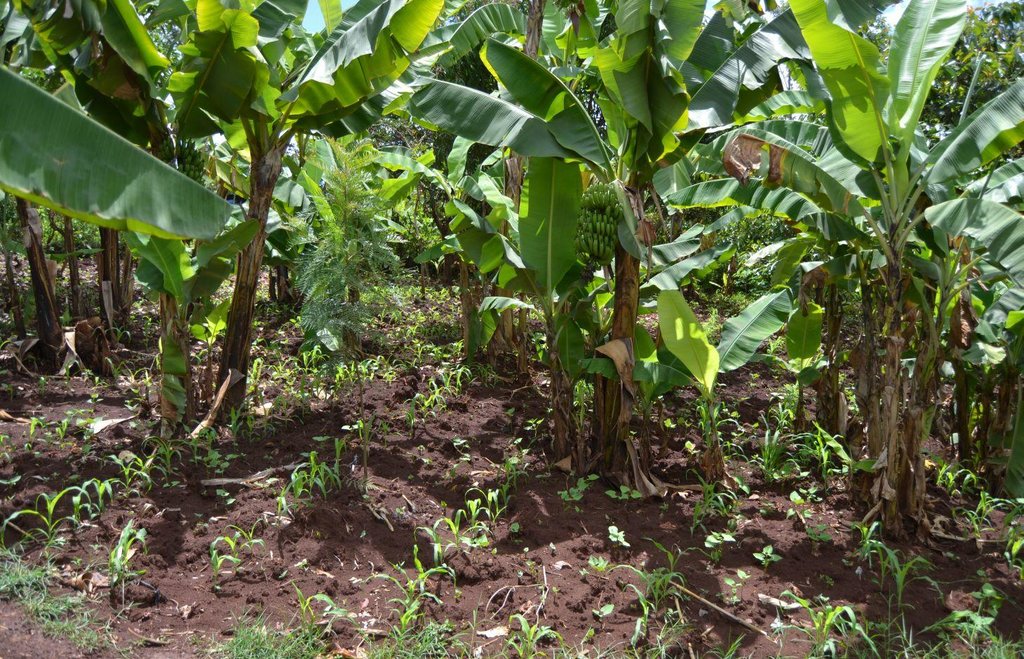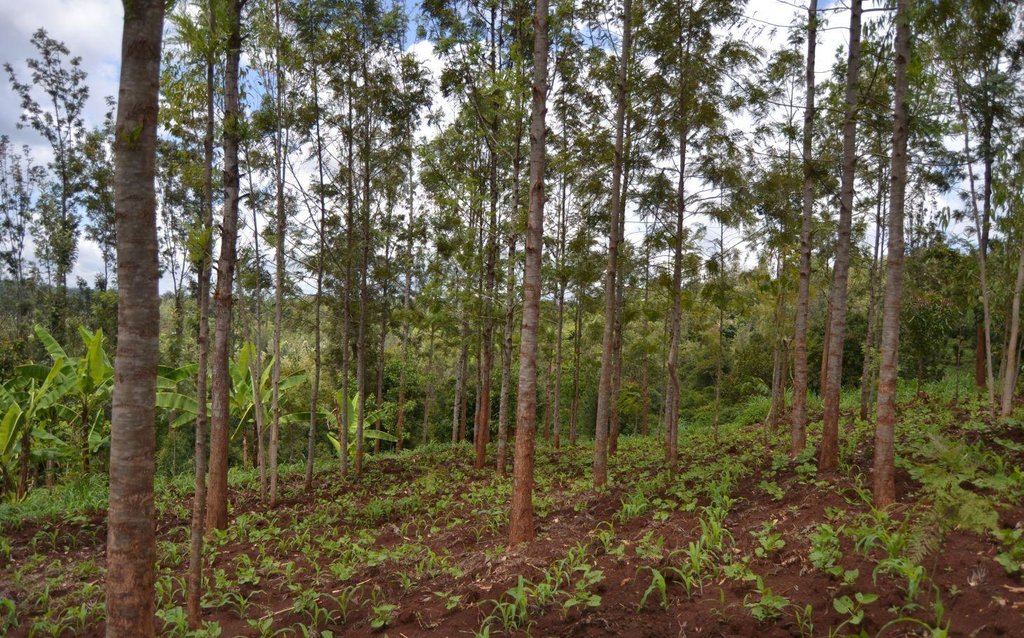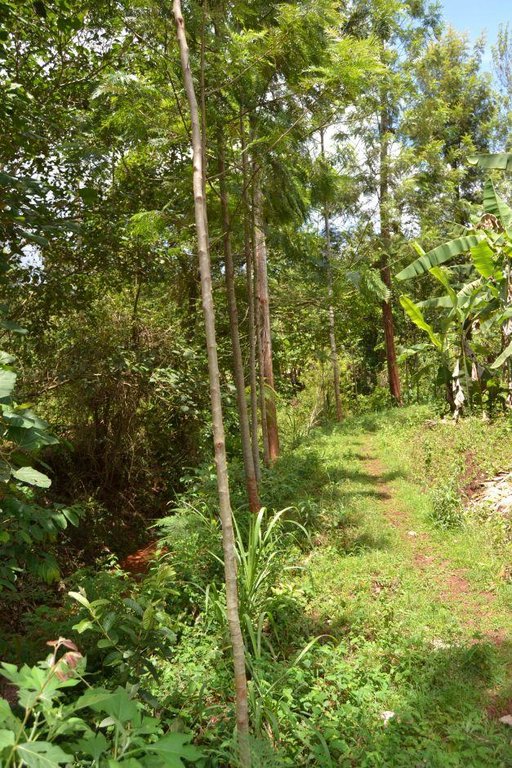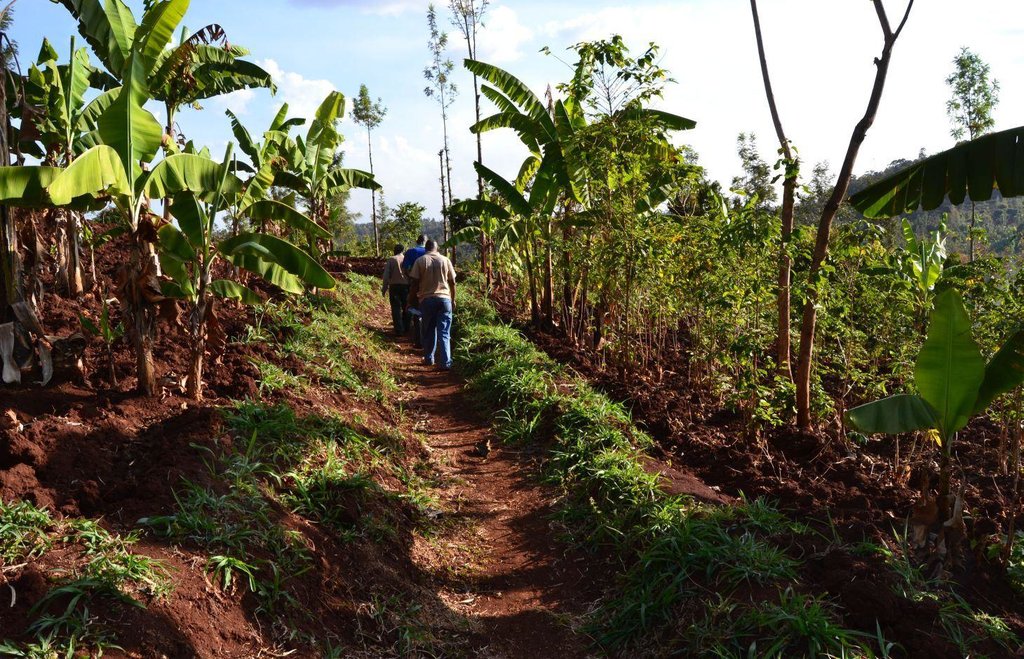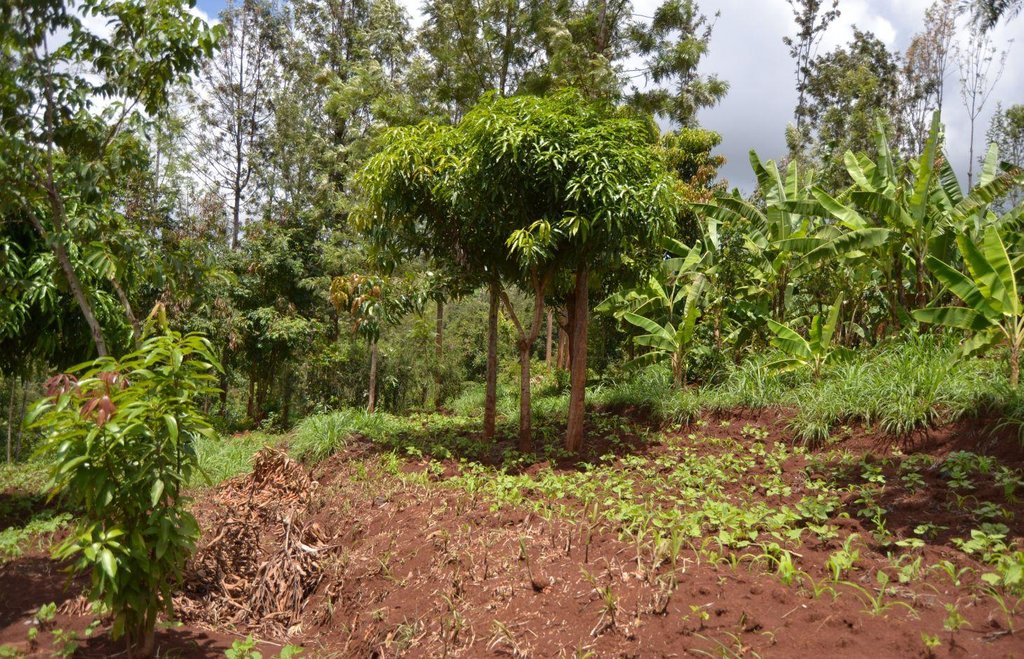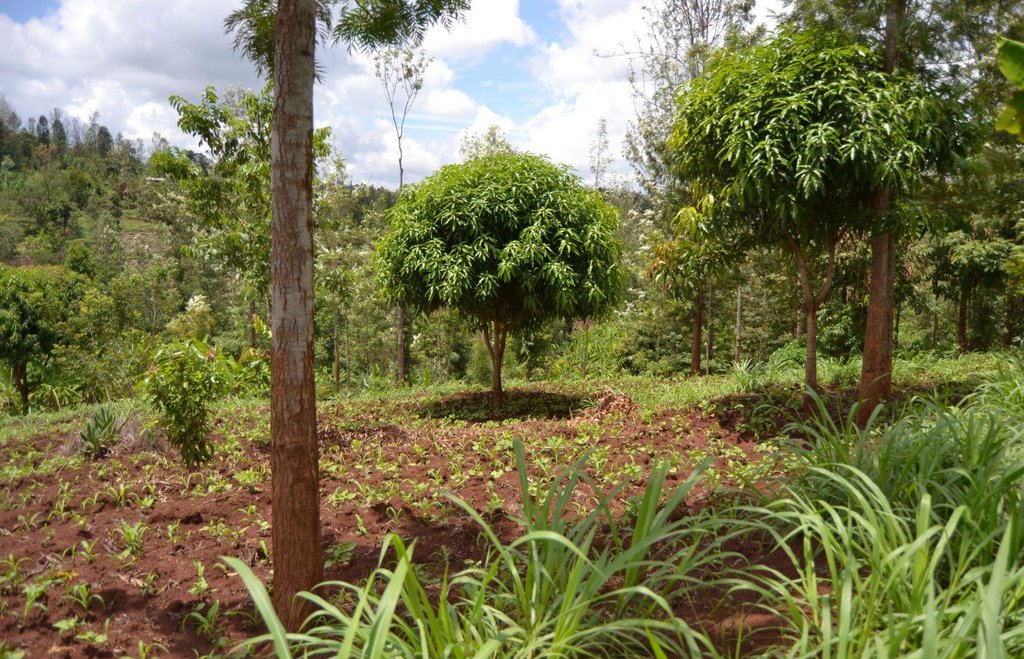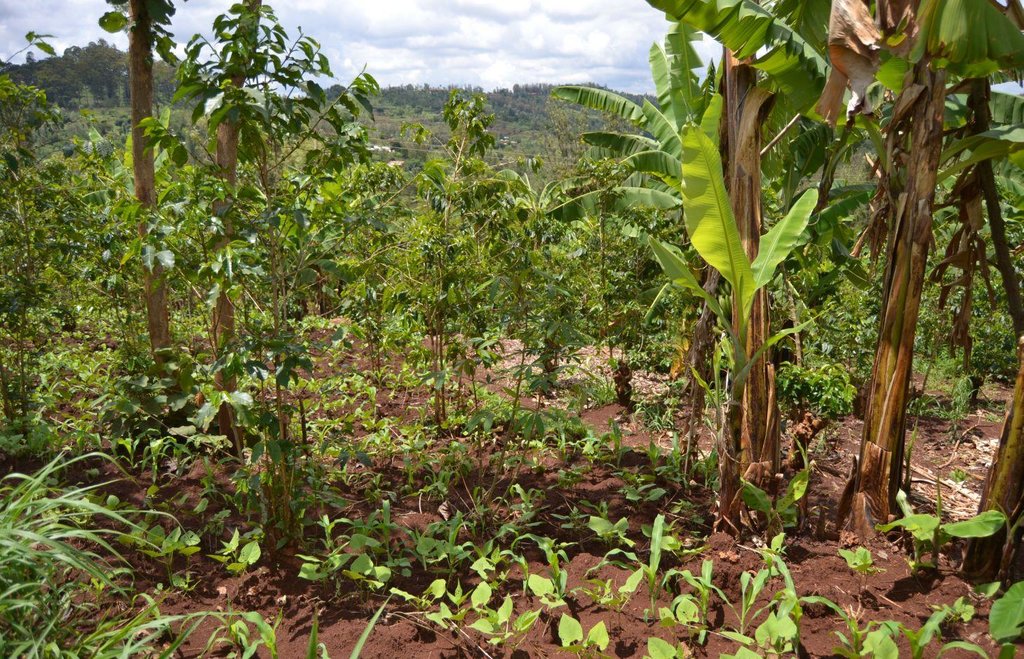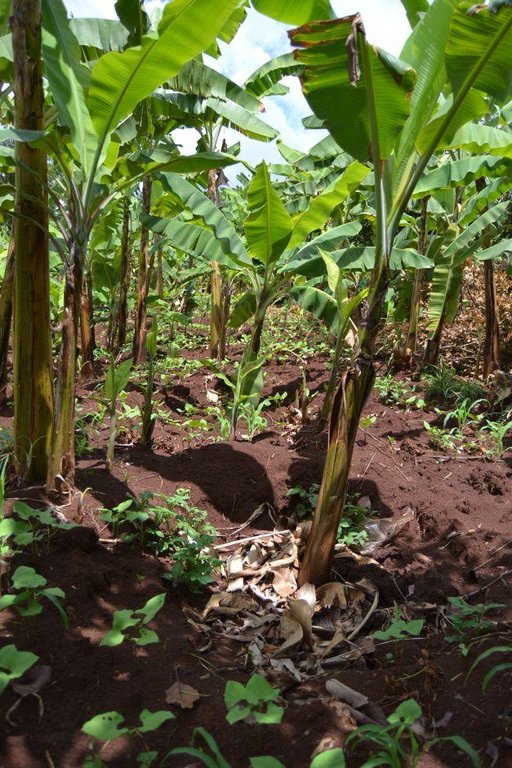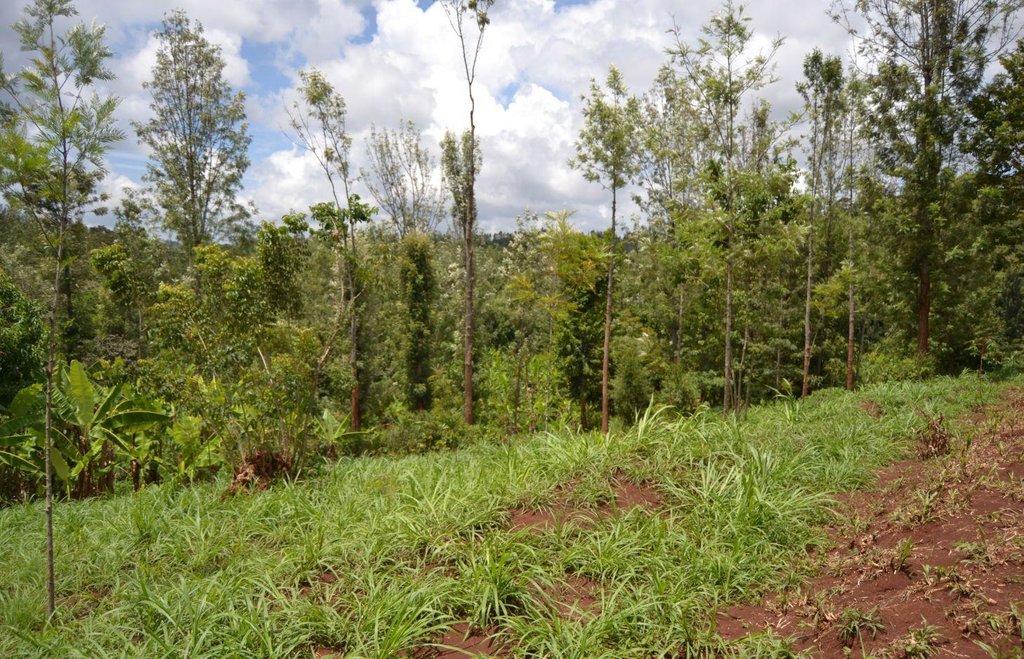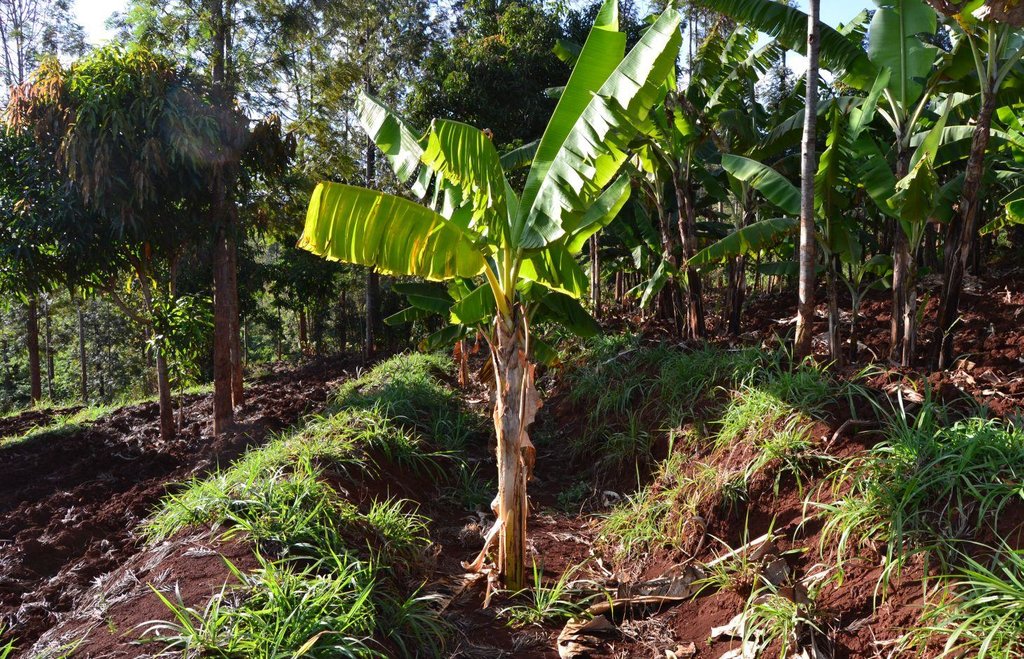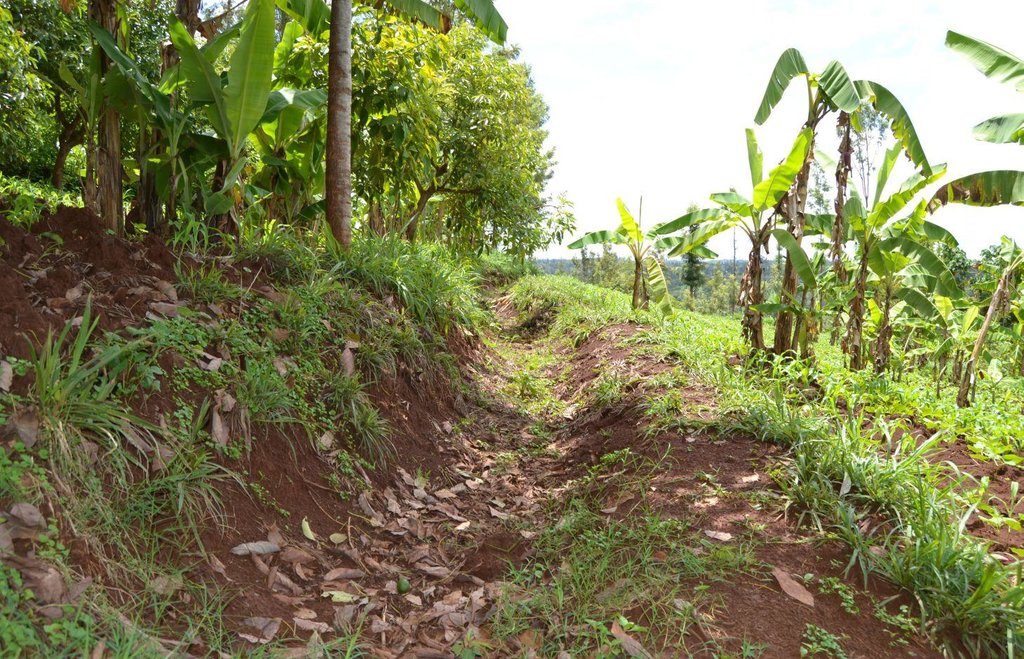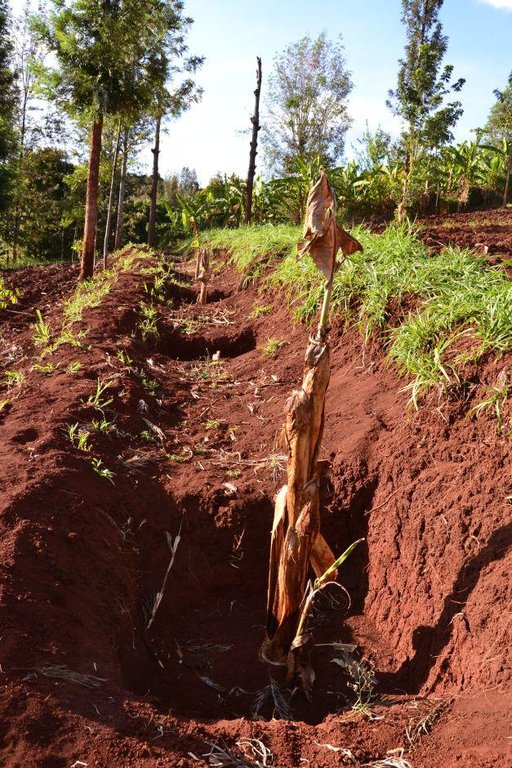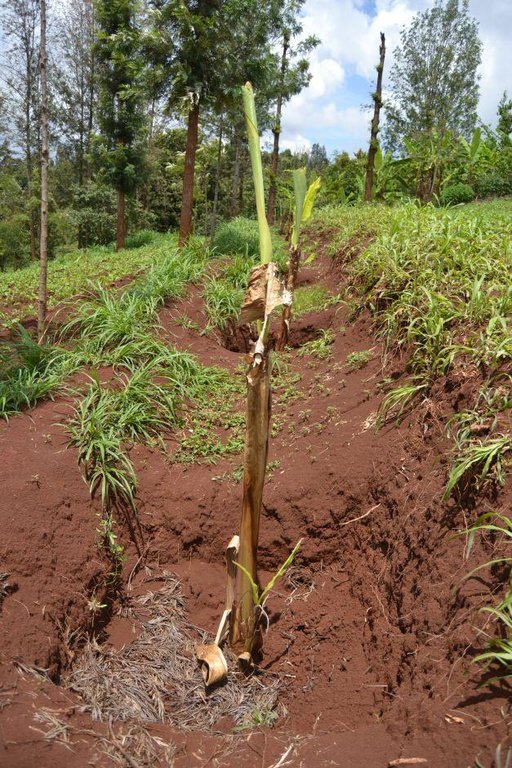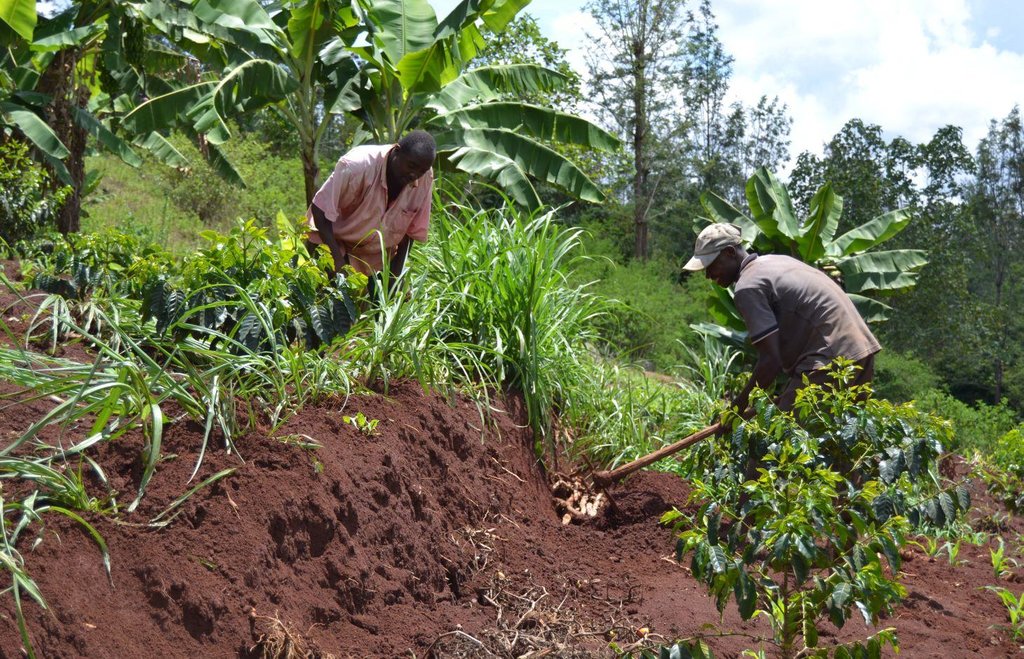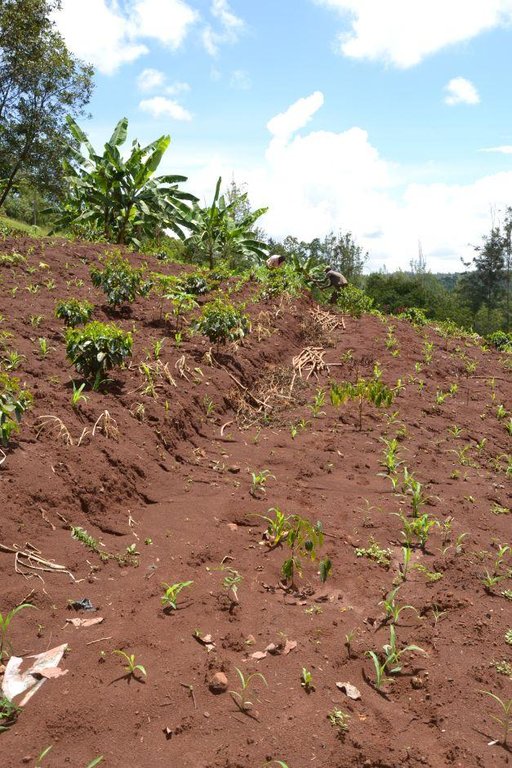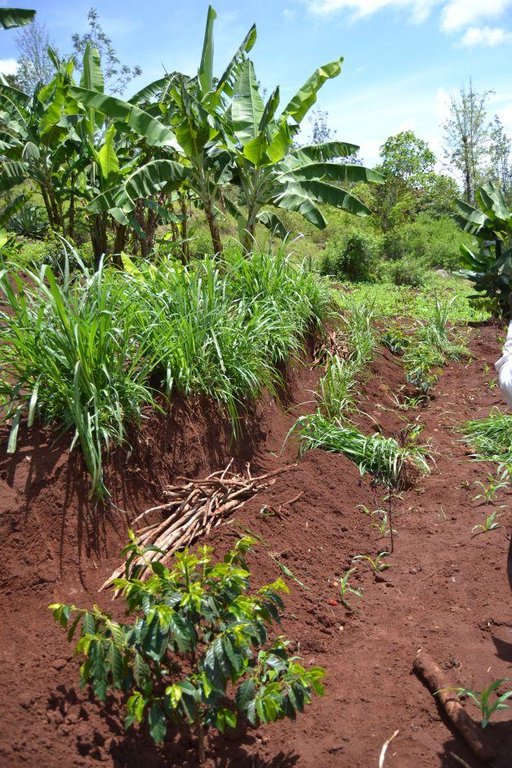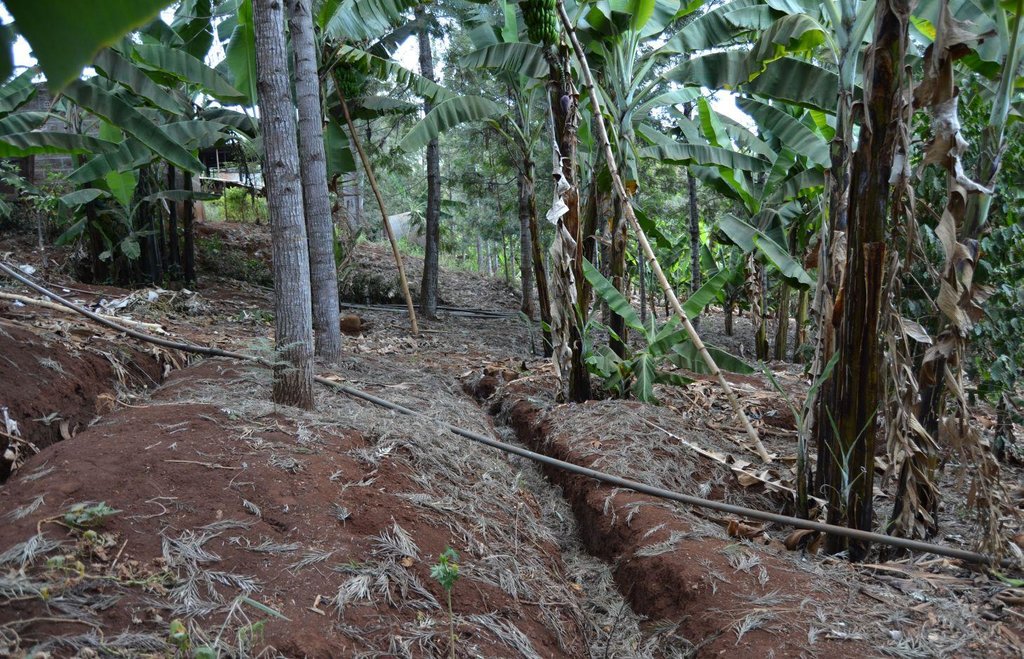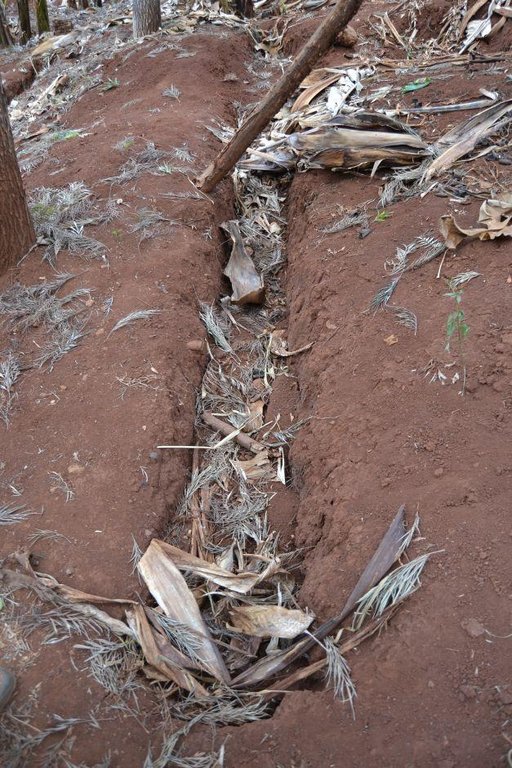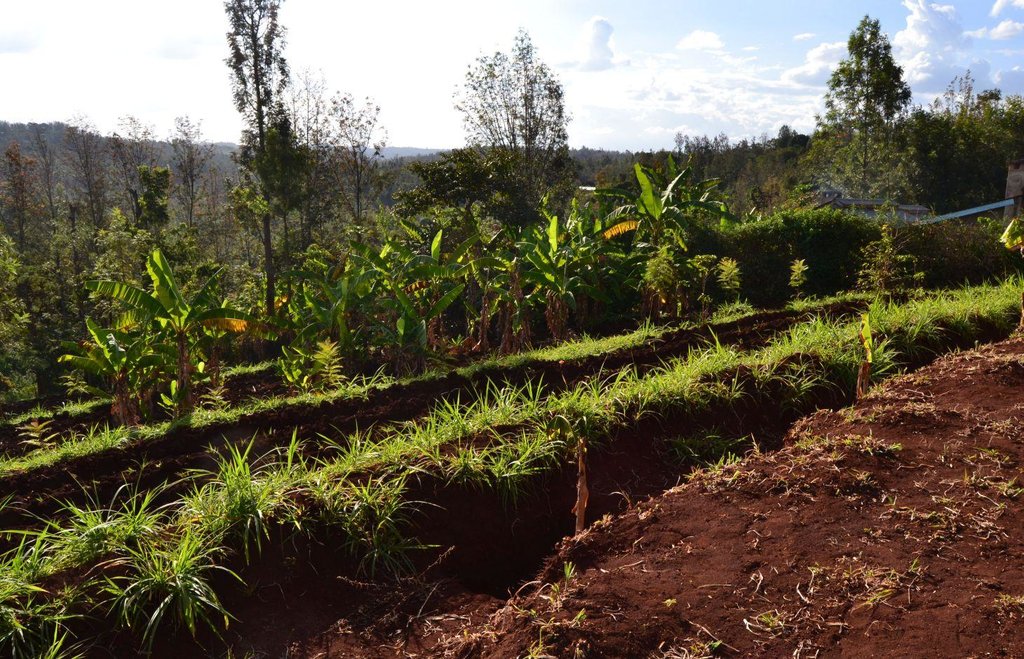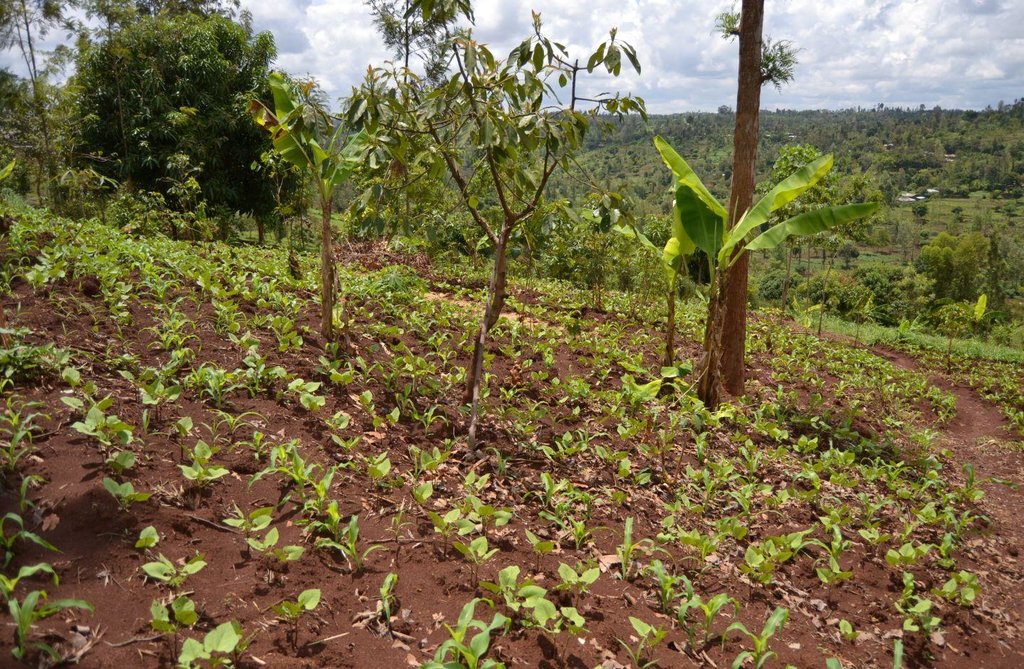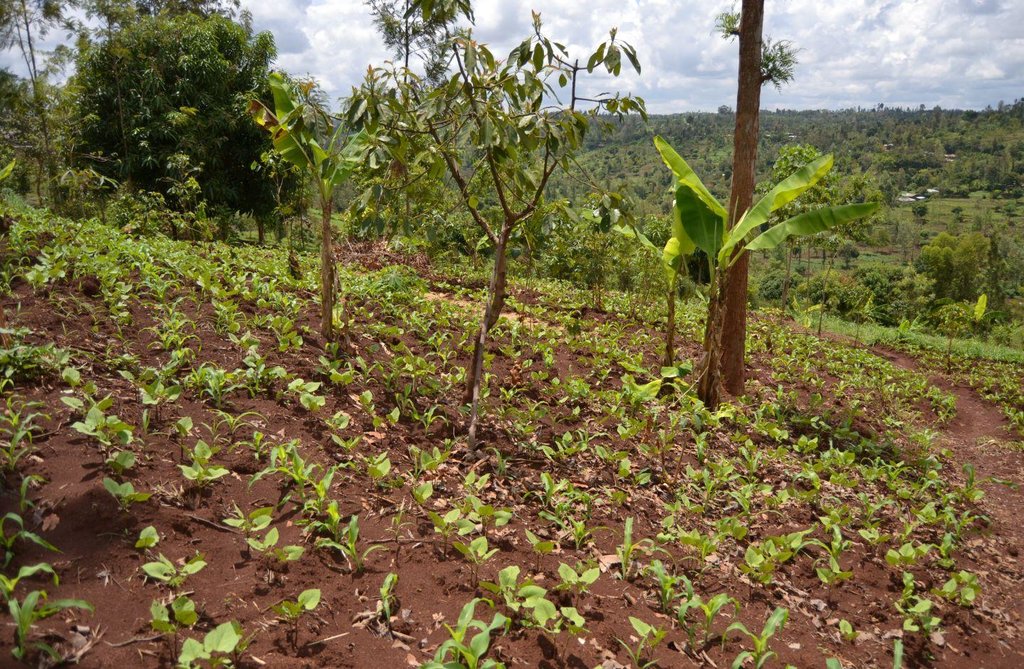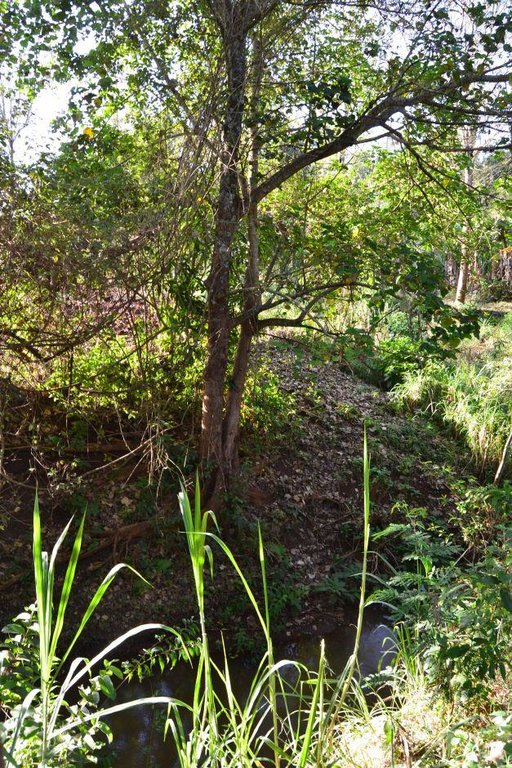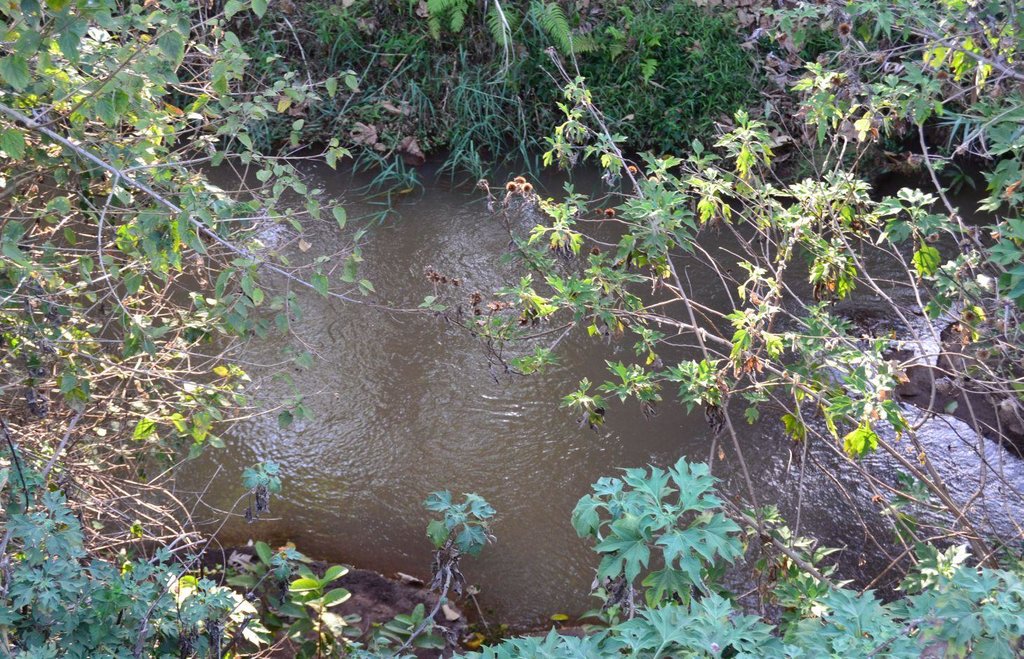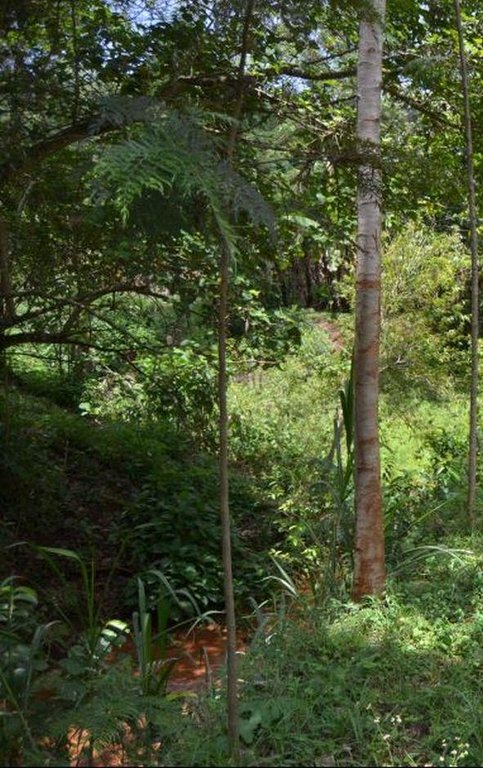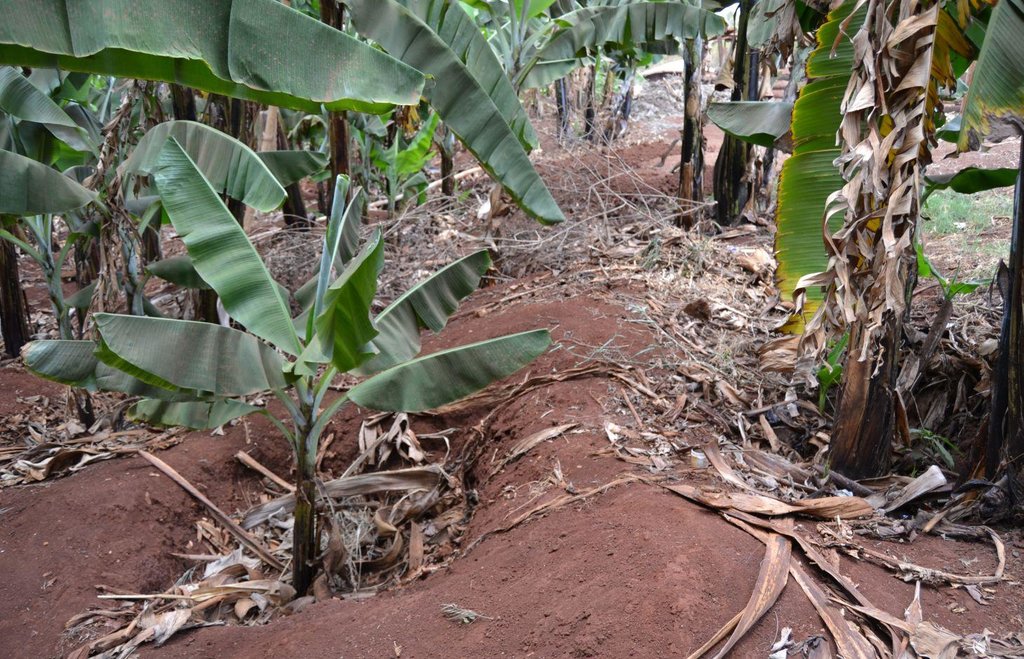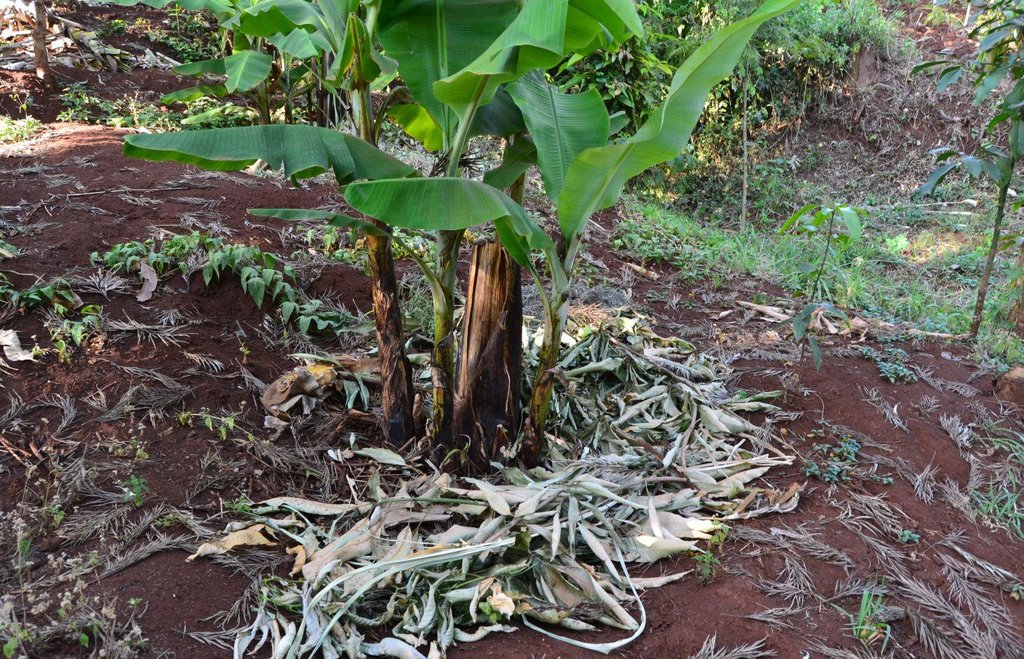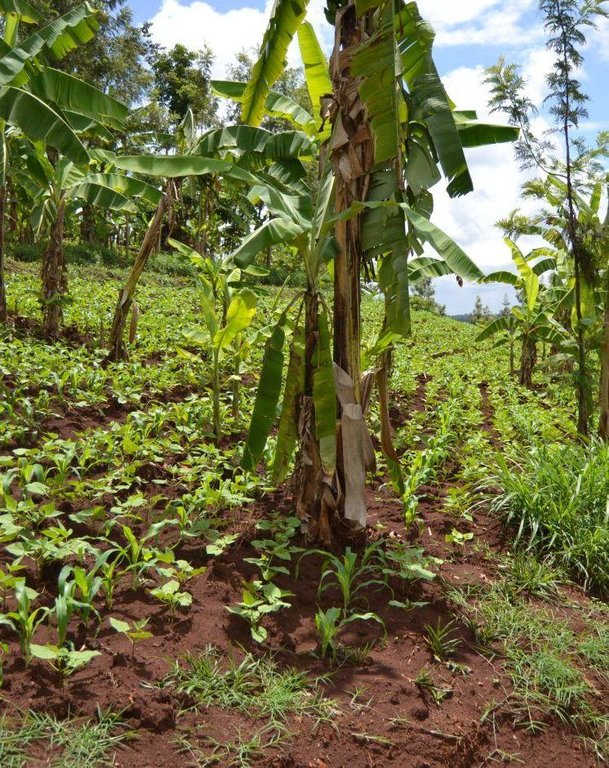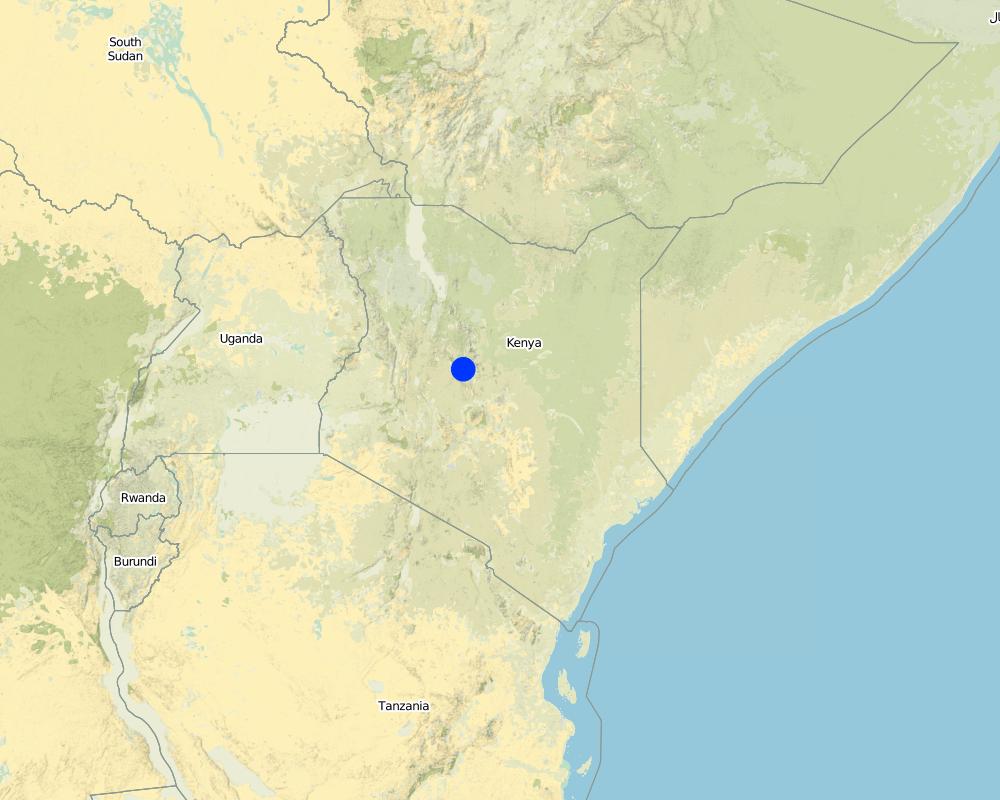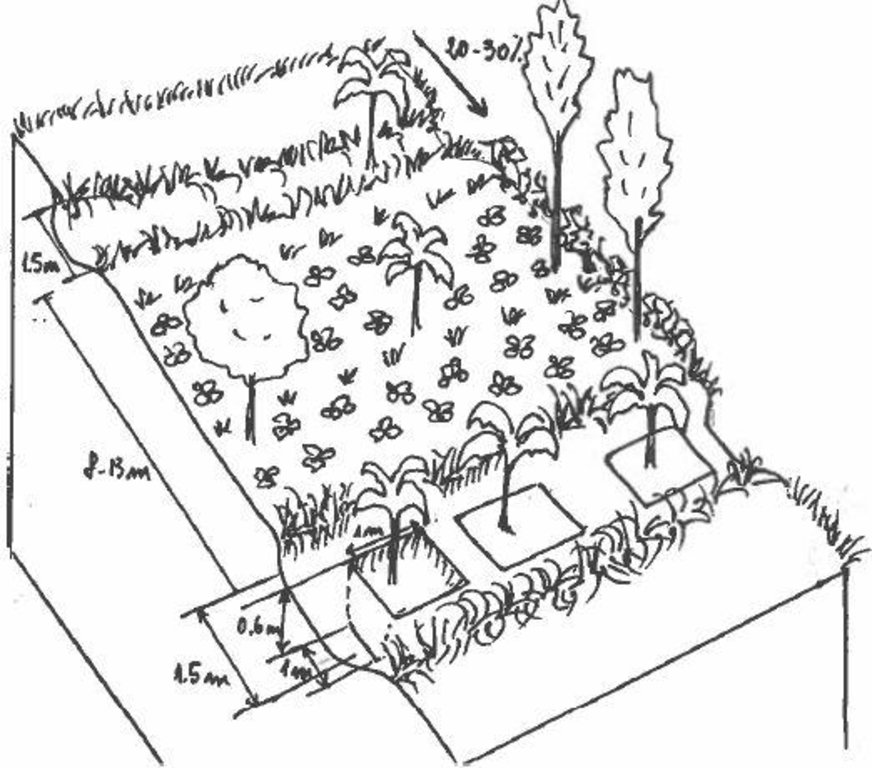Agroforestry land use in bench terraces with cut-off and infiltration ditches and Napier grass strips. [Kenya]
- Création :
- Mise à jour :
- Compilateur : Laura D'Aietti
- Rédacteur : –
- Examinateurs : Alexandra Gavilano, Fabian Ottiger
technologies_1159 - Kenya
- Résumé complet en PDF
- Résumé complet en PDF pour impression
- Résumé complet dans le navigateur
- Résumé complet (non formaté)
- Agroforestry land use in bench terraces with cut-off and infiltration ditches and Napier grass strips.: 29 décembre 2016 (inactive)
- Agroforestry land use in bench terraces with cut-off and infiltration ditches and Napier grass strips.: 5 juin 2017 (inactive)
- Agroforestry land use in bench terraces with cut-off and infiltration ditches and Napier grass strips.: 3 mai 2019 (public)
Voir les sections
Développer tout Réduire tout1. Informations générales
1.2 Coordonnées des personnes-ressources et des institutions impliquées dans l'évaluation et la documentation de la Technologie
Personne(s)-ressource(s) clé(s)
Spécialiste GDT:
F. K. Nyamu Jospeh
WRUA Sabasaba
Kenya
Nom du ou des institutions qui ont facilité la documentation/ l'évaluation de la Technologie (si pertinent)
Food and Agriculture Organization of the United Nations (FAO) - Italie1.3 Conditions relatives à l'utilisation par WOCAT des données documentées
Quand les données ont-elles été compilées (sur le terrain)?
02/11/2012
Le compilateur et la(les) personne(s) ressource(s) acceptent les conditions relatives à l'utilisation par WOCAT des données documentées:
Oui
2. Description de la Technologie de GDT
2.1 Courte description de la Technologie
Définition de la Technologie:
A combination of agricultural (e.g. intercropping, mulching, minimum tillage), vegetative (e.g. Napier grass strips, trees planting) and structural (e.g. ditches, bench terracing) measures which aim to maximise the overall yield in a sustainable manner (e.g. reduction of soil erosion and increasing the soil quality).
2.2 Description détaillée de la Technologie
Description:
The land of the farmer is of 3 acres: 2 acres to plant maize (Zea mays) intercropped with beans (Phaseolus vulgaris) in combination with several trees species: Mangoes, Avocadoes, Bananas, Grevillea and Makadamia and half acre for coffee plantation with Bananas and half with Napier grass production for fodder (to feed cows). To increase and fasten the grass growth, manure is applied twice a year, before the rainy season (around February and September), while mulching is practiced under Banana trees every season. Minimum tillage is applied to reduce soil disturbance and to increase water use efficiency by minimizing direct evaporation, increasing infiltration and water recharge (Liniger, 1991) especially during dry seasons, which results in better crop yields.
For timber production Grevillea trees are planted scattered overall the land and on the edge of the river for demarcation (environmental role in stabilizing the soil against erosive forces).
Concerning the structural measures, the farmer constructed has built 14 bench terraces, six of them were designed to plant cash crops (coffee); each terrace is characterized by a ditch to cut off the drainage and collect water and nutrients; they are also used as paths to facilitate transportation and farm operations. Ditches are both drainage and infiltration types and are excavated along the contour.
Purpose of the Technology: Beans and maize are cultivated for home consumption but partially (about 20%-4 bags of maize and half bag of beans) also for commercial purposes. Coffee is harvested twice a year, with a production of about 500 kg per season; the coffee is sold at 45 Kenyan Shillings (KSh) per kg (SL-28-arabica varieties). Indeed, the farmer is interested in cultivating the certified and improved variety called Ruiru 11 which is generally disease resistant, easy to maintain (less expensive) with a modest risk of pests (according to the farmer). Grevillea timber is sold twice a year, only trees of 1.5 feet in diameter (about 45 cm), at about 80 KSh per feet. Beside the commercial role of Grevillea, when sufficiently grown these trees lead to a reduction of the wind speed, protect the intercrops and provide mulching material to be used over banana trees. The deep roots of mature Grevillea are not in competition with the crops for soil and water, instead they enhance infiltration (Otengi, 2007). Makadamia will be used to produce cooking oil, while bananas, avocados and mangoes are fruits collected for the local markets. Napier grass is cultivated to stabilize the ditches and for fodder production.
Establishment / maintenance activities and inputs: There is a high initial input (mainly labour) needed to create ditches and terraces and for planting crops is required. The vegetative and structural measures require a labour intensive management during the year, for example maintenance is necessary after each rainy season to repair ditches and to rebuild terraces (e.g. because of the accumulation of soil and organic matter in the pits and ditches). Concerning Napier grass, labour is employed regularly for weed control, to cut grass for fodder and every three seasons to replace and replant the grass because it becomes less productive. Concerning trees, in the Agroforestry systems, canopies of Mango and Avocado trees shade the soil reducing evapotranspiration and therefore improving soil water storage. On the other hand, regular pruning is needed when the shadow effect obstructs photosynthesis and therefore growth of the crops planted below (maize and beans). Pruning of branches is carried out also for firewood. Furthermore, a common practice is Grevillea root pruning to conserve soil moisture (Otengi, 2007) and to reduce competition for nutrients during the growing season. Indeed, the farmer explained how superficial roots may interfere with the Banana root system and to cut them he has created small trenches. Harvesting is carried out twice during the year for both cereals and coffee.
Natural / human environment: The area is characterized by rolling to hilly slopes, therefore it is exposed to erosion and land degradation. The combination of trees with mixed crops is adopted to maximise productivity and at the same time to prevent degradation by increasing the vegetative cover.
2.3 Photos de la Technologie
2.5 Pays/ région/ lieux où la Technologie a été appliquée et qui sont couverts par cette évaluation
Pays:
Kenya
Région/ Etat/ Province:
Kenya
Autres spécifications du lieu:
Muthithi location-Kagurumo sublocation-Gatwamikwa village
Map
×2.6 Date de mise en œuvre de la Technologie
Si l'année précise est inconnue, indiquez la date approximative: :
- il y a plus de 50 ans (technologie traditionnelle)
2.7 Introduction de la Technologie
Spécifiez comment la Technologie a été introduite: :
- dans le cadre d'un système traditionnel (> 50 ans)
Commentaires (type de projet, etc.) :
The technology has been started by the father of the farmer about 70 years ago. His initiative has been developed and improved over time thanks also to the support of the MoA extension officers.
3. Classification de la Technologie de GDT
3.2 Type(s) actuel(s) d'utilisation des terres, là où la Technologie est appliquée

Pâturages
Pâturage intensif/ production fourragère :
- Affouragement en vert/ zéro-pâturage
Principales espèces animales et principaux produits:
Cut-and-carry/ zero grazing: fodder for 2 cows, from Napier grass

Mixte (cultures/ pâturages/ arbres), incluant l'agroforesterie
- Agroforesterie
Commentaires:
Major land use problems (compiler’s opinion): Soil erosion and nutrient leaching which could drain into the river (Fig. 17).
Major land use problems (land users’ perception): The most important limiting factor to the crop and fodder production remains water: not only related to the weather conditions (e.g. shorter and delayed rainy seasons) but due to the lack of a proper irrigation systems, to minimize the water losses and time. Furthermore, soil has been considered 'not good', because does not hold enough water due to the slope of the land.
Si l'utilisation des terres a changé en raison de la mise en œuvre de la Technologie, indiquez l'utilisation des terres avant la mise en œuvre de la Technologie:
Agroforestry
3.3 Informations complémentaires sur l'utilisation des terres
Approvisionnement en eau des terres sur lesquelles est appliquée la Technologie:
- pluvial
Nombre de période de croissance par an: :
- 2
Précisez:
Longest growing period in days: 122Longest growing period from month to month: from about March to JuneSecond longest growing period in days: 61Second longest growing period from month to month: from about October to November
Densité d'élevage/ chargement (si pertinent):
< 1 LU/km2
3.5 Diffusion de la Technologie
Spécifiez la diffusion de la Technologie:
- répartie uniformément sur une zone
Si la Technologie est uniformément répartie sur une zone, indiquez la superficie couverte approximative:
- < 0,1 km2 (10 ha)
Commentaires:
About 1.21 ha (3 acres).
The area accounts for the land owned and cultivated by the farmer. According to the interviewee from the Ministry of Agriculture, on average farmers in Saba Saba sub-catchment own 1 acre of land (Elemans, 2011).
3.6 Mesures de GDT constituant la Technologie

pratiques agronomiques
- A1: Couverture végétale/ du sol
- A2: Matière organique/ fertilité du sol
- A3: Traitement de la couche superficielle du sol

pratiques végétales
- V1: Couverture d’arbres et d’arbustes
- V2: Herbes et plantes herbacées pérennes

structures physiques
- S1: Terrasses
- S4: Fossés isohypses, trous
Commentaires:
Type of agronomic measures: mulching, legume inter-planting, manure / compost / residues, minimum tillage
Type of vegetative measures: aligned: -graded strips
3.7 Principaux types de dégradation des terres traités par la Technologie

érosion hydrique des sols
- Wt: perte de la couche superficielle des sols (couche arable)/ érosion de surface

dégradation chimique des sols
- Cn: baisse de la fertilité des sols et réduction du niveau de matière organique (non causée par l’érosion)

dégradation hydrique
- Hp: baisse de la qualité des eaux de surface
Commentaires:
Main causes of degradation: soil management (Poor soil management practices), deforestation / removal of natural vegetation (incl. forest fires) (Poor vegetation cover, mainly herbaceous), disturbance of water cycle (infiltration / runoff) (Land use: cropland), other natural causes (avalanches, volcanic eruptions, mud flows, highly susceptible natural resources, extreme topography, etc.) specify (From gentle to hilly slope)
Secondary causes of degradation: Heavy / extreme rainfall (intensity/amounts) (Especially during wet seasons: March-June and October-November)
3.8 Prévention, réduction de la dégradation ou réhabilitation des terres dégradées
Spécifiez l'objectif de la Technologie au regard de la dégradation des terres:
- prévenir la dégradation des terres
- réduire la dégradation des terres
4. Spécifications techniques, activités, intrants et coûts de mise en œuvre
4.1 Dessin technique de la Technologie
4.2 Spécification/ explications techniques du dessin technique
Detailed overview of the Agroforestry system in a bench terrace with infiltration (retention) and cut off (drainage) ditches. Along them, strips of Napier grass on both sides.
Location: Upper Saba saba river. Kagurumo in Muthithi location
Technical knowledge required for land users: moderate
Main technical functions: control of dispersed runoff: retain / trap, control of dispersed runoff: impede / retard, reduction of slope angle, reduction of slope length, improvement of ground cover, increase in organic matter, increase of infiltration, increase / maintain water stored in soil, water harvesting / increase water supply, sediment retention / trapping, sediment harvesting
Secondary technical functions: improvement of topsoil structure (compaction), stabilisation of soil (eg by tree roots against land slides), increase in nutrient availability (supply, recycling,…), improvement of water quality, buffering / filtering water, increase of biomass (quantity)
Mulching
Material/ species: Organic residues around Banana trees
Quantity/ density: undefined
Legume inter-planting
Quantity/ density: 3bags270kg
Manure / compost / residues
Material/ species: Manure from two cows
Quantity/ density: 8 tonnes
Remarks: for 1 year
Aligned: -graded strips
Vegetative material: G : grass
Number of plants per (ha): 400 grass per2lines strip
Vertical interval between rows / strips / blocks (m): few cm
Spacing between rows / strips / blocks (m): 1
Vertical interval within rows / strips / blocks (m): 0.4
Width within rows / strips / blocks (m): 0.6-1
Scattered / dispersed
Vegetative material: T : trees / shrubs, F : fruit trees / shrubs
Number of plants per (ha): about 80
Trees/ shrubs species: Grevillea, Coffee
Fruit trees / shrubs species: Persea americana, Musa sapientum, Mangifera indica, Macadamia tetraphylla
Grass species: Pennisetum pyramidalis (Napier grass or elephant grass)
Slope (which determines the spacing indicated above): 20-25%
If the original slope has changed as a result of the Technology, the slope today is (see figure below): 15%
Gradient along the rows / strips: 5-8%
Diversion ditch/ drainage
Vertical interval between structures (m): 1
Spacing between structures (m): 8-13
Depth of ditches/pits/dams (m): 0.6-1
Retention/infiltration ditch/pit, sediment/sand trap
Vertical interval between structures (m): 1
Spacing between structures (m): 8-13
Depth of ditches/pits/dams (m): 0.6-1
Terrace: forward sloping
Vertical interval between structures (m): 1
Spacing between structures (m): 12-15
Slope (which determines the spacing indicated above): 5-8 (moderate) (Fig.4-7Annex3)%
If the original slope has changed as a result of the Technology, the slope today is: 5%
Lateral gradient along the structure: 25-30%
4.3 Informations générales sur le calcul des intrants et des coûts
autre/ monnaie nationale (précisez):
Kenyan Schellings
Indiquer le taux de change du dollars en monnaie locale (si pertinent): 1 USD= :
85,9
Indiquez le coût salarial moyen de la main d'œuvre par jour:
2.00
4.4 Activités de mise en place/ d'établissement
| Activité | Type de mesures | Calendrier | |
|---|---|---|---|
| 1. | Digging holes and planting Coffee seedlings (20 KSh per plant) | Végétale | |
| 2. | Digging holes (1 feet ×1 feet) and planting trees (seedlings)- 4 days ×5 persons at Ksh 200.e.g. the main work consist of digging small pits for bananas (300 plants) | Végétale | |
| 3. | Establishment of the infiltration ditches and cutoff drains (total 5). 3p.d. (200 Ksh *3) each. | Structurel | Each season: during dry season |
| 4. | Establishment of the retention ditches with bench terraces (tot.8): 2 p.d., 250 Ksh per day | Structurel | Each season: during dry season |
| 5. | Purchase cows | Agronomique |
Commentaires:
Life span of the cows: Several years
4.5 Coûts et intrants nécessaires à la mise en place
| Spécifiez les intrants | Unité | Quantité | Coûts par unité | Coût total par intrant | % des coût supporté par les exploitants des terres | |
|---|---|---|---|---|---|---|
| Main d'œuvre | Digging holes and planting seedlings | person/day | 20,0 | 2,3 | 46,0 | 100,0 |
| Main d'œuvre | Infiltration ditches | person/day | 1,0 | 1277,0 | 1277,0 | 100,0 |
| Main d'œuvre | Establishment of the infiltration ditches and cutoff drains (total 5) | person/day | 15,0 | 2,333 | 35,0 | 100,0 |
| Main d'œuvre | stablishment of the retention ditches with bench terraces (tot.8) | person/day | 16,0 | 2,9375 | 47,0 | 100,0 |
| Equipements | Cow | pieces | 2,0 | 349,0 | 698,0 | |
| Matériel végétal | Seedlings Mango | pieces | 10,0 | 0,2 | 2,0 | 100,0 |
| Matériel végétal | Coffee seedlings | pieces | 250,0 | 0,464 | 116,0 | 100,0 |
| Matériel végétal | Seedlings Avocado | pieces | 12,0 | 0,25 | 3,0 | 100,0 |
| Matériel végétal | Seedlings Macadamia | pieces | 8,0 | 0,25 | 2,0 | 100,0 |
| Matériel végétal | Grevillea | pieces | 50,0 | 0,12 | 6,0 | 100,0 |
| Autre | cows | animal | 2,0 | 349,0 | 698,0 | 100,0 |
| Coût total de mise en place de la Technologie | 2930,0 | |||||
Commentaires:
Duration of establishment phase: 6 month(s)
4.6 Activités d'entretien/ récurrentes
| Activité | Type de mesures | Calendrier/ fréquence | |
|---|---|---|---|
| 1. | Minimum tillage and planting maize and beans | Agronomique | 2 times in a year |
| 2. | Harvesting maize/beans (around Feb/March and Ag/Sept) | Agronomique | 2 times in a year |
| 3. | Feeding cows on daily basis (normally 3 times a day): 200 Ksh is the price of 1 labour to feed the cows with lunch, for 6 days | Agronomique | daily basis |
| 4. | Preparation and application of manure | Agronomique | 2 times in a year |
| 5. | Digging planting holes and planting grass | Végétale | 2 times (because they get 'old') or 1 half year, depending on the conditions |
| 6. | Maintenance of the grass (weed control and cutting Napier grass/repairing and collecting fodder) | Végétale | Every season (March/Sept); cutting Napier: 2times in a season |
| 7. | Clearing the tree for selling timber (the price depends also of the use of the chainsaw (or saw) or not -(considering 4 trees at the time) - with machine operator | Végétale | When in need of cash (not regularly), not less than 5 years after planting |
| 8. | Prepare manure and feeding cows on daily basis (normally 3 times a day): 200 Ksh is the price of 1 labour to feed the cows with lunch, for 6 days (7200 for 6 months) | Végétale | Every season |
| 9. | Pruning branches/roots and let them dry for firewood- (considering 4 trees at the time) 3 persons days- 200Ksh | Végétale | Every 3 seasons (and when shortage of firewood) |
| 10. | Mulching | Végétale | Twice in the year on Bananas |
| 11. | Harvesting coffee | Végétale | Twice in the year |
| 12. | Distribute manure on Napier grass, also in the pits | Végétale | 2 times |
| 13. | Repairing the ditches and remove excess of soil/leaves accumulated during the rainy season | Structurel | After rains (every season) |
| 14. | Rebuilt repair terraces | Structurel | 3 times per year |
4.7 Coûts et intrants nécessaires aux activités d'entretien/ récurrentes (par an)
| Spécifiez les intrants | Unité | Quantité | Coûts par unité | Coût total par intrant | % des coût supporté par les exploitants des terres | |
|---|---|---|---|---|---|---|
| Main d'œuvre | Minimum tillage and planting maize and beans | person/days | 15,0 | 1,5333 | 23,0 | 100,0 |
| Main d'œuvre | Harvesting maize/beans | person/days | 10,0 | 1,2 | 12,0 | 100,0 |
| Main d'œuvre | Feeding cows and preparing the manure on daily basis | person/days | 312,0 | 0,166666 | 52,0 | 100,0 |
| Main d'œuvre | Preparation and application of manure | person/days | 2,0 | 2,5 | 5,0 | 100,0 |
| Matériel végétal | Seeds Maize | kg | 10,0 | 2,3 | 23,0 | 100,0 |
| Matériel végétal | Seeds Beans | kg | 5,0 | 2,0 | 10,0 | 100,0 |
| Matériel végétal | Seedlings grass | per trench | 200,0 | |||
| Autre | Labour: Digging planting holes and planting grass | person/days | 5,0 | 1,8 | 9,0 | 100,0 |
| Autre | Labour: Maintenance of the grass (weed control and cutting Napier grass/repairing and collecting fodder) | person/days | 3,0 | 1,66666 | 5,0 | 100,0 |
| Autre | Labour: Clearing the tree for selling timber (the price depends also of the use of the chainsaw (or saw) or not -(considering 4 trees at the time) - with machine operator | person/days | 1,0 | 8,0 | 8,0 | 100,0 |
| Autre | Labour: Repairing the ditches and remove excess of soil/leaves accumulated during the rainy season | person/days | 2,0 | 2,5 | 5,0 | 100,0 |
| Autre | Labour: Rebuilt repair terraces | person/days | 5,0 | 1,8 | 9,0 | 100,0 |
| Coût total d'entretien de la Technologie | 161,0 | |||||
Commentaires:
Machinery/ tools: panga, fork djembe, hoes, shovel, fork djembe, panga, saw, shovels, fork djembe
The costs has been computed during the period of the field visit and include all the costs for the establishment and the maintenance of the different measures (structural, agronomic and vegetative), for 3 acre of land.
4.8 Facteurs les plus importants affectant les coûts
Décrivez les facteurs les plus importants affectant les coûts :
In the farmer's opinion, the main constrains are the costs carried out to maintain the structural measures described. Water instead become the limiting environmental factor during dry season.
5. Environnement naturel et humain
5.1 Climat
Précipitations annuelles
- < 250 mm
- 251-500 mm
- 501-750 mm
- 751-1000 mm
- 1001-1500 mm
- 1501-2000 mm
- 2001-3000 mm
- 3001-4000 mm
- > 4000 mm
Zone agro-climatique
- subhumide
Thermal climate class: subtropics. June, July and August
5.2 Topographie
Pentes moyennes:
- plat (0-2 %)
- faible (3-5%)
- modéré (6-10%)
- onduleux (11-15%)
- vallonné (16-30%)
- raide (31-60%)
- très raide (>60%)
Reliefs:
- plateaux/ plaines
- crêtes
- flancs/ pentes de montagne
- flancs/ pentes de colline
- piémonts/ glacis (bas de pente)
- fonds de vallée/bas-fonds
Zones altitudinales:
- 0-100 m
- 101-500 m
- 501-1000 m
- 1001-1500 m
- 1501-2000 m
- 2001-2500 m
- 2501-3000 m
- 3001-4000 m
- > 4000 m
5.3 Sols
Profondeur moyenne du sol:
- très superficiel (0-20 cm)
- superficiel (21-50 cm)
- modérément profond (51-80 cm)
- profond (81-120 cm)
- très profond (>120 cm)
Texture du sol (de la couche arable):
- moyen (limoneux)
Matière organique de la couche arable:
- faible (<1%)
5.4 Disponibilité et qualité de l'eau
Profondeur estimée de l’eau dans le sol:
> 50 m
Disponibilité de l’eau de surface:
moyenne
Qualité de l’eau (non traitée):
eau potable
5.5 Biodiversité
Diversité des espèces:
- moyenne
5.6 Caractéristiques des exploitants des terres appliquant la Technologie
Orientation du système de production:
- subsistance (auto-approvisionnement)
- mixte (de subsistance/ commercial)
Revenus hors exploitation:
- > 50% de tous les revenus
Niveau relatif de richesse:
- moyen
Individus ou groupes:
- individu/ ménage
Niveau de mécanisation:
- travail manuel
Genre:
- femmes
- hommes
Indiquez toute autre caractéristique pertinente des exploitants des terres:
Population density: 10-50 persons/km2
Annual population growth: 2% - 3%
Off-farm income specification: The farmer is rich because he owns 3 acre of land and livestock, assets (electricity) which are above the average standards of the community. No family food insecure issues during all year, and he was a teacher.
5.7 Superficie moyenne des terres détenues ou louées par les exploitants appliquant la Technologie
- < 0,5 ha
- 0,5-1 ha
- 1-2 ha
- 2-5 ha
- 5-15 ha
- 15-50 ha
- 50-100 ha
- 100-500 ha
- 500-1 000 ha
- 1 000-10 000 ha
- > 10 000 ha
Cette superficie est-elle considérée comme de petite, moyenne ou grande dimension (en se référant au contexte local)?
- petite dimension
5.8 Propriété foncière, droits d’utilisation des terres et de l'eau
Propriété foncière:
- individu, sans titre de propriété
Droits d’utilisation des terres:
- individuel
Droits d’utilisation de l’eau:
- accès libre (non organisé)
Commentaires:
Water use rights depend on the use: open access for drinking and domestic uses.
5.9 Accès aux services et aux infrastructures
santé:
- pauvre
- modéré
- bonne
éducation:
- pauvre
- modéré
- bonne
assistance technique:
- pauvre
- modéré
- bonne
emploi (par ex. hors exploitation):
- pauvre
- modéré
- bonne
marchés:
- pauvre
- modéré
- bonne
énergie:
- pauvre
- modéré
- bonne
routes et transports:
- pauvre
- modéré
- bonne
eau potable et assainissement:
- pauvre
- modéré
- bonne
services financiers:
- pauvre
- modéré
- bonne
6. Impacts et conclusions
6.1 Impacts sur site que la Technologie a montrés
Impacts socio-économiques
Production
production agricole
production fourragère
production de bois
Revenus et coûts
dépenses pour les intrants agricoles
revenus agricoles
Impacts socioculturels
sécurité alimentaire/ autosuffisance
situation des groupes socialement et économiquement désavantagés
Impacts écologiques
Cycle de l'eau/ ruissellement
ruissellement de surface
évaporation
Sols
humidité du sol
couverture du sol
perte en sol
Biodiversité: végétale, animale
biomasse/ au dessus du sol C
6.2 Impacts hors site que la Technologie a montrés
disponibilité de l'eau
envasement en aval
capacité tampon/de filtration
6.3 Exposition et sensibilité de la Technologie aux changements progressifs et aux évènements extrêmes/catastrophes liés au climat (telles que perçues par les exploitants des terres)
Changements climatiques progressifs
Changements climatiques progressifs
| Saison | Type de changements/ extrêmes climatiques | Comment la Technologie fait-elle face à cela? | |
|---|---|---|---|
| températures annuelles | augmente | pas connu |
Extrêmes climatiques (catastrophes)
Catastrophes météorologiques
| Comment la Technologie fait-elle face à cela? | |
|---|---|
| pluie torrentielle locale | bien |
| tempête de vent locale | bien |
Catastrophes climatiques
| Comment la Technologie fait-elle face à cela? | |
|---|---|
| sécheresse | pas bien |
Catastrophes hydrologiques
| Comment la Technologie fait-elle face à cela? | |
|---|---|
| inondation générale (rivière) | bien |
Autres conséquences liées au climat
Autres conséquences liées au climat
| Comment la Technologie fait-elle face à cela? | |
|---|---|
| réduction de la période de croissance | pas connu |
6.4 Analyse coûts-bénéfices
Quels sont les bénéfices comparativement aux coûts de mise en place (du point de vue des exploitants des terres)?
Rentabilité à court terme:
légèrement négative
Rentabilité à long terme:
légèrement positive
Quels sont les bénéfices comparativement aux coûts d'entretien récurrents (du point de vue des exploitants des terres)?
Rentabilité à court terme:
légèrement positive
Rentabilité à long terme:
positive
6.5 Adoption de la Technologie
Parmi tous ceux qui ont adopté la Technologie, combien d'entre eux l'ont fait spontanément, à savoir sans recevoir aucune incitation matérielle ou aucun paiement?
- 0-10%
Commentaires:
1% of land user families have adopted the Technology without any external material support
There is a moderate trend towards spontaneous adoption of the Technology
6.7 Points forts/ avantages/ possibilités de la Technologie
| Points forts/ avantages/ possibilités du point de vue du compilateur ou d'une autre personne ressource clé |
|---|
|
Agroforestry (dispersed trees on cropland) and intercropping: The technology is simple to adopt and provides a sustainable land management with a diversified source of income/ food supply. How can they be sustained / enhanced? Implementation could focus on the increase of species: Jaetzold et al. (1982) underlines the positive impacts of the use of biomass from Mucuna, Crotalaria, Tithonia, Calliandra and Leucanean hedges/trees for soil fertility improvements, increasing grain yields. Crop rotation and leaving crop residues on the ground could further help increasing the production. |
|
Napier grass has been used for different purposes: e.g. ditch stabilization, fodder production. How can they be sustained / enhanced? Other herbaceous vegetation could also be planted: e.g. Tithonia diversifolia (Mexican sunflower),an excellent green manure and medicinal plant. |
6.8 Faiblesses/ inconvénients/ risques de la Technologie et moyens de les surmonter
| Faiblesses/ inconvénients/ risques du point de vue de l’exploitant des terres | Comment peuvent-ils être surmontés? |
|---|---|
| The amount of work required to carry out all the activities is too much. |
| Faiblesses/ inconvénients/ risques du point de vue du compilateur ou d'une autre personne ressource clé | Comment peuvent-ils être surmontés? |
|---|---|
| The technologies in place require regular maintenance especially during rainy seasons. |
7. Références et liens
7.2 Références des publications disponibles
Titre, auteur, année, ISBN:
Jaetzold R., and Schmidt H., 1983. Farm Management Handbook of Kenya. Natural Conditions and Farm Management Information. Vol. 2.Part B: Central Kenya.
Disponible à partir d'où? Coût?
http://www2.gtz.de/dokumente/bib/07-1284.pdf
Titre, auteur, année, ISBN:
Jaetzold R., Schmidt H., Hornetz B., Shisanya C., 1982. Farm Management Handbook of Kenya. Natural Conditions and Farm Management Information. West Kenya, Subpart A2. Nyanza Province.
Disponible à partir d'où? Coût?
http://www2.gtz.de/dokumente/bib/07-1284.pdf
Titre, auteur, année, ISBN:
Liniger HP (1991). Water conservation for rainfall farming in the semi-arid Footzones northwest of Mt. Kenya (Laikipia highlands). Consequence on the water balance and the soil productivity. Laikipia/Mt. Kenya PaperD-3, Nairobi, Kenya & Bern, Switzerland.
Titre, auteur, année, ISBN:
Ouma J. O., Murithi F. M., Mwangi W., Verguijl H., Gethi M., De Groote H., 2002. Adoption of maize seed and fertilizer technologies in Embu District, Kenya. KARI, CYMMIT.
Titre, auteur, année, ISBN:
Otengi S. B. B., Stigter C. J., Ng'anga J. K. N. H. Liniger H. P., 2007. Soil moisture and its consequences under different management in a six year old hedged agroforestry demonstration plot in semi-arid Kenya, for two successive contrasting seasons. African Journal of Agricultural Research Vol. 2(3), pp. 089-104.
Titre, auteur, année, ISBN:
Storey P. J., 2002. The conservation and improvement of sloping land. Volume 1: Practical understanding. Chapter 5: Improving the soil management.
Liens et modules
Développer tout Réduire toutLiens
Aucun lien
Modules
Aucun module trouvé


